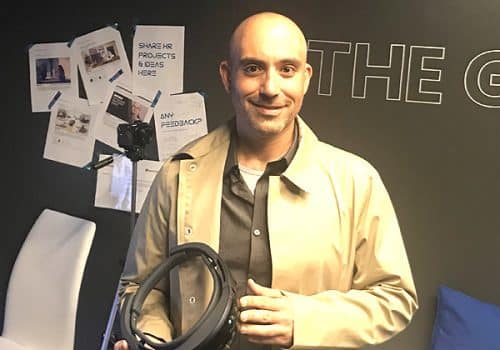"Israel is the only place where hospitals will bring technology in and try it out," said Guy Shalu, the manager of Microsoft's garage in Israel, and explained why innovative projects are being developed here

Microsoft and the Rabin Medical Center have developed a liver cancer surgery system with the help of holograms and HoloLens glasses, as Guy Shalu, the manager of Microsoft's garage in Israel, presented to journalists from Europe and Israel who toured the giant's headquarters in Redmond.
In an interview with people and computers in the garage building in Redmond, he explained why innovative projects are being developed in Israel. "Israel is the only place where hospitals will bring technology in and try it out," he said.
According to him, "The project is a collaboration between the garage and the Billinson Hospital at the Rabin Medical Center. The purpose of the project is to help surgeons who perform operations to remove tumors from the liver, to get a three-dimensional view of the liver and the location of the blood vessels within it from the CT scan - something that allows them to see the boundaries of the tumor in real time, reduces the need to do an ultrasound during surgery, reduces the need to send pieces From the tumor to the pathology during surgery, shortens the surgery, increases the chances of success."
But something no less important, said Shalu, "the system makes it possible to bridge the gap between experienced doctors and novice doctors because it gives the novice surgeon a real-time view of the liver without opening it." It bridges the gap and ensures that we get a better quality of analysis.”
What's interesting, he said, "is that the medical center saw the liver surgery and came to the conclusion that there are surgeries that need it even more urgently - joint replacement surgeries, for example. During a joint replacement, we put a type of metal ball that replaces the joint, and it must be placed in a three-dimensional space on three axes Y, X and Z in order to cause as little pain as possible to the patient until the joint is put back together."
"The methods that exist today to perform joint replacement surgery are very outdated. The holographic solution makes it possible to place artificial joints in space precisely."
How did the idea come about?
"The idea arose from the hospital's need to allow its staff to get better use of the imaging done before the operation, the idea was brought up by Prof. Hanoch Kashtan, a highly respected surgeon in his field, who came to me together with an intern named Oren Zlotnik, said Shalu. "Prof. Kashtan's vision and his many years of experience with Oren's need and technological ability, created a type of demand that we were happy to respond to, and we created the system."
"Microsoft Garage in Israel works very hard to promote innovation that has real value behind it for the industry in general," he said. "We focus on joint projects that the work with will yield some kind of advantage for the Israeli industry in general. Remember that the garage exists in India, China, Canada and of course the United States, but what is special to us in Israel is the time it takes from the moment someone had an idea until a meeting was scheduled and until we set off. It has no second. Our ability to try things even in an operating room is an extraordinary thing. The Israeli approach that accepts innovation and wants to help patients as much as possible to lead the medical field is very special."
We want people who do - not talk
Ed Assay, Director of the Global Garage Program at Microsoft explained that the idea of establishing spaces where Microsoft employees could try out their ideas, with all possible tools, from advanced electronics to carpentry and sewing, while collaborating between employees from different disciplines.
"We encourage experimentation and testing ideas that will help us grow. We stand behind Microsoft CEO Satya Nadella's vision of 'One Microsoft'. We want people who do - not talk."
We have such spaces in six Microsoft sites around the world - Silicon Valley, Vancouver, Cambridge, Beijing, Hydrabad and Herzliya. The first garage opened in 2009 when Steve Ballmer was the company's president, but has evolved greatly since Nadella took over. We provide each employee with the materials they need, and help them move forward in testing the idea.
"The spaces of the garages are also used to manage the hackathons, including the largest hackathon in the world that takes place simultaneously in 75-80 countries around the world. Over 18 people joined Microsoft's hackathons last year, and we're opening it up to small countries and inviting nonprofits so we can hack for humanity. This is the largest investment of buildings for non-profit organizations. We also run a scholarship program for teenagers and students."
The 48-hour hackathons spread over many sites and extensive time zones, allow people to do things that are important to them - for example the hackathon for women, the hackathon for Africa and more. You don't have to be a programmer to participate in a hackathon. On the contrary, we want to combine a wide variety of specializations from different fields, which allows ideas to take off."

3 תגובות
When did I claim otherwise?
So capitalism and private medicine is good for miracles? Have you repented?
""Israel is the only place where hospitals will bring technology in and try it out" - this is absolutely not true! From my experience, it is much easier to introduce innovative technology in US hospitals than in Israel.
In the USA - there is great competition between the hospitals and advanced technology is definitely "known".
In Israel - "I don't need your technology... maybe it can help less good doctors...".
I am very happy that Guy Shalu succeeded, but it is not because it is easier in Israel.